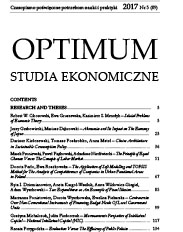Istota reformy rolnej w II Rzeczypospolitej
Agrarian Reform in Second Polish Republic
Author(s): Czesław NoniewiczSubject(s): Agriculture, Political history, Social history
Published by: Wydawnictwo Uniwersytetu w Białymstoku
Keywords: Second Polish Republic; agrarian reform
Summary/Abstract: The Act of 1920 provided for compulsory subdivision of estates and transfer of land to the peasantry at half the market price. An obstacle to the implementation of the law was the constitutional clause of the inviolability of private property passed in 1921. It was only the Act of 1925, providing for the sale of land at market price, that was deemed to be compatible with the Constitution. Two essential factors influenced the implementation of the agrarian reform of 1926: the price of land and the demand for land. Professor Witold Staniewicz, the Minister of Agrarian Reform in the years 1926-1930, divided the reform into two stages: besides the breaking up of estates, intense accumulation of land in peasant farms was undertaken. He regarded the subdivision of estates as a factor conducive to the change of spatial arrangement of lands. The reform was to involve a lengthy process of parcellation of estates and land regrouping. It is possible to compare it with the reform of enfranchisement in the Prussian Partition in the nineteenth century. The essence of the land reform in the Second Polish Republic was a long-term strengthening of family farms.
Journal: Optimum. Economic Studies
- Issue Year: 84/2016
- Issue No: 6
- Page Range: 76-82
- Page Count: 17
- Language: Polish

